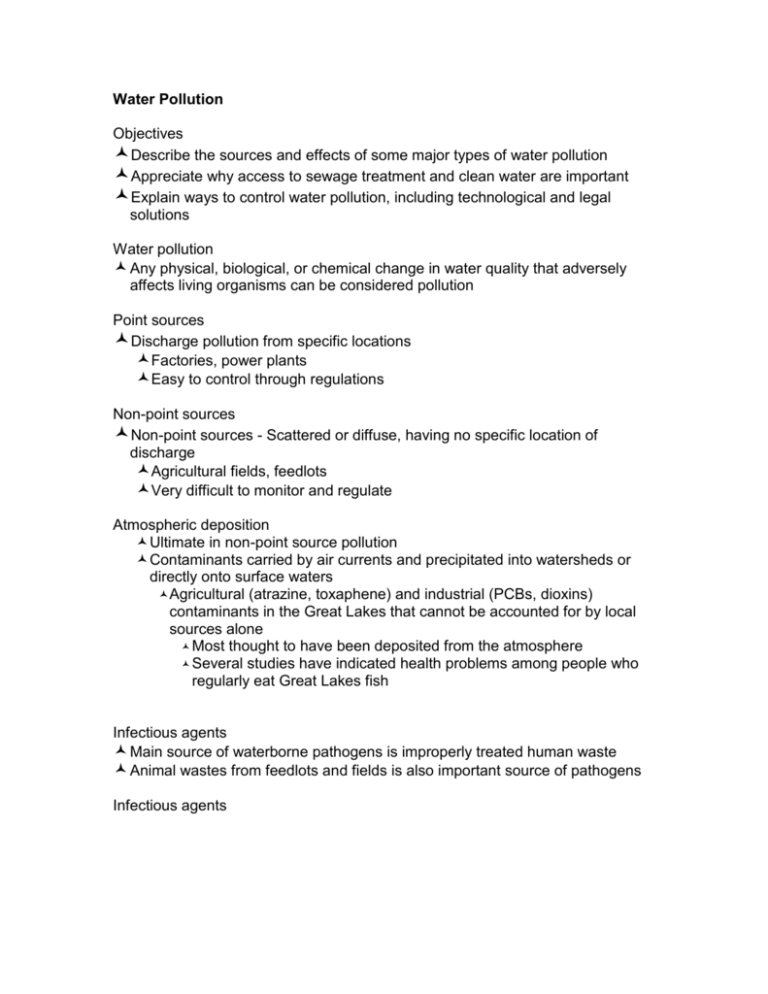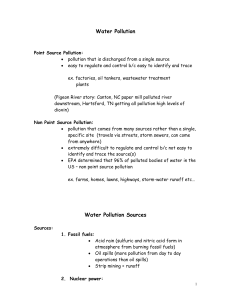Water Pollution
advertisement

Water Pollution Objectives Describe the sources and effects of some major types of water pollution Appreciate why access to sewage treatment and clean water are important Explain ways to control water pollution, including technological and legal solutions Water pollution Any physical, biological, or chemical change in water quality that adversely affects living organisms can be considered pollution Point sources Discharge pollution from specific locations Factories, power plants Easy to control through regulations Non-point sources Non-point sources - Scattered or diffuse, having no specific location of discharge Agricultural fields, feedlots Very difficult to monitor and regulate Atmospheric deposition Ultimate in non-point source pollution Contaminants carried by air currents and precipitated into watersheds or directly onto surface waters Agricultural (atrazine, toxaphene) and industrial (PCBs, dioxins) contaminants in the Great Lakes that cannot be accounted for by local sources alone Most thought to have been deposited from the atmosphere Several studies have indicated health problems among people who regularly eat Great Lakes fish Infectious agents Main source of waterborne pathogens is improperly treated human waste Animal wastes from feedlots and fields is also important source of pathogens Infectious agents Infectious agents In developed countries, sewage treatment plants and pollution-control devices have greatly reduced pathogens Waters monitored for coliform bacteria - intestinal bacteria including Escherichia coli (E. coli) Estimated 1.5 million Americans fall ill from fecal contamination annually Drinking water generally disinfected via chlorination Oxygen-demanding wastes Certain organic materials added to water stimulates oxygen consumption by decomposers Sewage Paper pulp Food-processing wastes Oxygen-demanding wastes Water with an oxygen content > 6 ppm will support “desirable” aquatic life Water with < 2 ppm oxygen will support mainly detritis feeders and decomposers (e.g. worms, bacteria, fungi) Oxygen is added to water by diffusion from wind and waves, and by photosynthesis from green plants and algae Oxygen is removed from water by respiration and oxygen-consuming chemical processes Oxygen-demanding wastes Effects of oxygen-demanding wastes on rivers depend on volume, flow, and temperature of river water Faster flowing water has more oxygen Lower temperature water has more oxygen Oxygen sag - oxygen levels decline downstream from a pollution source as decomposers metabolize waste materials Oxygen sag Oxygen sag Plant nutrients and cultural eutrophication Oligotrophic - Bodies of water that have clear water and low biological productivity Eutrophic - Bodies of water that are rich in organisms and organic material Eutrophication - Process of increasing nutrient levels and biological productivity Some amount of eutrophication is normal Cultural eutrophication - Increase in biological productivity and ecosystem succession caused by human activities Eutrophication Eutrophication Gulf of Mexico hypoxia In 1974, scientists found areas where oxygen had disappeared from bottom sediments and the water column First thought to be a minor natural disturbance Hypoxic area in 1993 after Mississippi floods doubled in size Stays from May to September Influx of nitrogen from Midwest/Great Plains is cause Hypoxic area continues to grow Harmful algal blooms (HABs) HABs have become increasingly common in slow-moving and shallow waters, usually due to pollution Algal blooms produce toxins Red tides are blooms of deadly aquatic algae Cryptosporidium in 1993 entered the Milwaukee public water supply, making 400,000 people sick and killing at least 100 people Pfiesteria piscicida First discovered in 1988 in open sores in fish in Chesapeake Bay Very complicated life cycle No fewer than 24 different life forms In 1997, fish kills led to the closing of Pocomoke River to all shellfish and fish harvests Economic loss was $15-20 million in MD alone Causes skin rashes, neurological disorders and death in humans Inorganic pollutants Metals Many metals such as mercury, lead, cadmium, and nickel are highly toxic Highly persistent and tend to bioaccumulate in food chains Lead pipes are a serious source of drinking water pollution Mine drainage is serious source of metal pollution in water Inorganic pollutants Nonmetallic salts Many salts that are non-toxic at low concentrations can be mobilized by irrigation and concentrated by evaporation, reaching levels toxic to plants and animals Leaching of road salts has had detrimental effect on many ecosystems Acids and bases Often released as by-products of industrial processes Coal mining Acid precipitation Organic chemicals Thousands of natural and synthetic organic chemicals are used to make pesticides, plastics, pharmaceuticals, pigments, etc. Many are highly toxic and bioaccumulate Organic chemicals Two most important sources of toxic organic chemicals in water are: Improper disposal of industrial and household wastes Runoff of pesticides from high-use areas Fields, roadsides, golf courses Pesticide runoff Sediment Human activities have accelerated erosion rates in many areas Human-induced erosion and runoff contribute about 75 billion metric tons of suspended solids to world surfaces each year Fills lakes, obstructs shipping channels, makes drinking water purification more costly Thermal pollution Raising or lowering water temperatures from normal levels can adversely affect water quality and aquatic life Oxygen solubility in water decreases as temperatures increase Species requiring high oxygen levels are adversely affected by warming water Thermal pollution Caused by altering vegetation cover and runoff patterns Industrial cooling processes often use heat-exchangers to extract excess heat, and then discharge heated water back into original source Ocean pollution Estimated 6 million metric tons of plastic bottles, packaging material, and other litter tossed from ships into the ocean annually Oil pollution Few coastlines in the world remain uncontaminated by oil or oil products Estimated 3-6 million metric tons of oil are discharged into the world’s oceans Transport creates opportunities for major spills Oil pollution Groundwater and drinking water About half the U.S. population, and 95% of rural residents, depend on underground aquifers for drinking water For decades, groundwater was assumed impervious to pollution and was considered the gold standard for water quality Groundwater and drinking water EPA estimates 4.5 trillion liters of contaminated water seep into the ground in the U.S. every day MTBE - Gasoline additive, and suspected carcinogen, is present in many urban aquifers In agricultural areas, fertilizers and pesticides commonly contaminate aquifers and wells Groundwater pollution Water pollution control Source reduction Cheapest and most effective way to reduce pollution is avoid producing it or releasing it into the environment Studies show as much as 90% less road salt can be used without significantly affecting winter road safety Soil conservation Non-point sources and land management Some main causes of non-point pollution: Agriculture Urban runoff Construction sites Land disposal Preserving wetlands In urban areas, reducing materials carried away by storm runoff is helpful Watershed protection in the Catskills Water supply for New York City Worked with local farmers to reduce non-point pollution and preserve land Saved billions of dollars by performing watershed protection rather than building a treatment plant Human waste disposal More than 500 pathogenic bacteria, viruses, and parasites can travel from human or animal excrement through water Natural processes In many areas, outdoor urination and defecation is the norm When population densities are low, natural processes can quickly eliminate waste Municipal sewage treatment Primary Treatment - Physical separation of large solids from the waste stream Secondary Treatment - Biological degradation of dissolved organic compounds Effluent from primary treatment transferred into trickling bed, or aeration tank Effluent from secondary treatment is usually disinfected (chlorinated) before release into nearby waterway Municipal sewage treatment Tertiary treatment - Removal of plant nutrients (nitrates and phosphates) from secondary effluent. Chemicals, or natural wetlands In many U.S. cities, sanitary sewers are connected to storm sewers Heavy storms can overload the system, causing by-pass dumping of raw sewage and toxic runoff directly into watercourses Low-cost waste treatment Living systems such as wetlands Effluent flows through wetlands where it is filtered and cleaned by aquatic plants and microscopic organisms Water legislation Clean Water Act (1972) Goal was to return all U.S. surface waters to “fishable and swimmable” conditions For Point Sources, Discharge Permits and Best Practicable Control Technology (BPT) are required Clean Water Act (1972) Areas of contention Draining or filling of wetlands Many consider this taking of private land Un-funded mandates State or local governments must spend monies not repaid by Congress Other important water legislation Safe Drinking Water Act (1974) Regulates water quality CERCLA (1980) (aka Superfund) Cleans up abandoned or inactive sites Great Lakes Water Quality Agreement (1972) London Dumping Convention (1990) Other important water legislation Laws are only as good as: To the degree they are not weakened To the degree they are funded Water quality today in US Areas of Progress In 1999, EPA reported 91.4% of all monitored river miles and 87.5% of all accessed lake acres are suitable for their designated uses Most progress due to municipal sewage treatment facilities Remaining problems Greatest impediments to achieving national goals in water quality are sediment, nutrients, and pathogens, especially from non-point discharges About three-quarters of water pollution in the U.S. comes from soil erosion, air pollution fallout, and agricultural and urban runoff Surface waters in other countries At least 2.5 billion people in less developed countries lack adequate sanitation, and about half of these lack access to clean drinking water Sewage treatment in wealthier countries of Europe generally equal or surpass the U.S. In Russia, only about half of the tap water supply is safe to drink Surface waters in other countries In urban areas of South America, Africa, and Asia, 95% of all sewage is discharged untreated into rivers Two-thirds of India’s surface waters are contaminated sufficiently to be considered dangerous to human health







